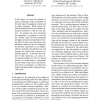Free Online Productivity Tools
i2Speak
i2Symbol
i2OCR
iTex2Img
iWeb2Print
iWeb2Shot
i2Type
iPdf2Split
iPdf2Merge
i2Bopomofo
i2Arabic
i2Style
i2Image
i2PDF
iLatex2Rtf
Sci2ools
118
click to vote
ACL
2010
2010
Cross Lingual Adaptation: An Experiment on Sentiment Classifications
In this paper, we study the problem of using an annotated corpus in English for the same natural language processing task in another language. While various machine translation systems are available, automated translation is still far from perfect. To minimize the noise introduced by translations, we propose to use only key `reliable" parts from the translations and apply structural correspondence learning (SCL) to find a low dimensional representation shared by the two languages. We perform experiments on an EnglishChinese sentiment classification task and compare our results with a previous cotraining approach. To alleviate the problem of data sparseness, we create extra pseudo-examples for SCL by making queries to a search engine. Experiments on real-world on-line review data demonstrate the two techniques can effectively improve the performance compared to previous work.
ACL 2010 | Computational Linguistics | Low Dimensional Representation | Sentiment Classification Task | Various Machine Translation |
Related Content
| Added | 10 Feb 2011 |
| Updated | 10 Feb 2011 |
| Type | Journal |
| Year | 2010 |
| Where | ACL |
| Authors | Bin Wei, Christopher Pal |
Comments (0)

